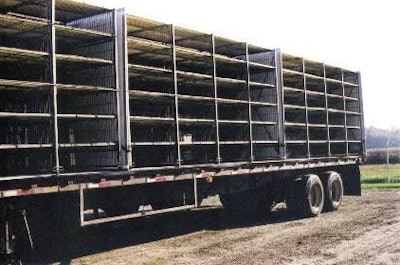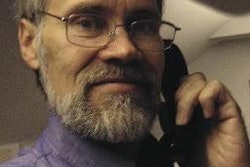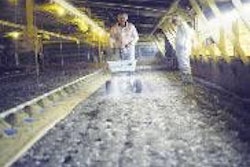
Tom turkeys raised for deboning keep getting bigger, and as they have gotten heavier, they have also become harder for live hangers to handle.
Traditionally, turkeys are brought to the plant in trailers in cages fixed to the truck. At the plant, the live hangers remove the birds from the cages and hang them on the shackle line. Not only do the bigger birds require more human strength to unload and hang, a little more amperage from the electrical stunning equipment is required to properly stun the birds. The combination of additional effort needed to remove larger birds from cages and hang them on the line coupled with increased amperage to stun them can lead to more carcass damage, which means yield losses from blood spots in the meat, broken wings and bruising on legs and wings.
“The Cooper organization knew that the animal handling issue [at the processing plant] was just something that we were going to have to face,” said Dale Hart, general manager of the Cooper Farms processing plant in St. Henry, Ohio. “As the turkeys have gotten bigger, it has gotten more difficult to handle them.”
Over the years as the genetics of turkeys have been improved, Cooper Farms has been increasing the market weight of the roughly 18,000 toms per day that the company processes on a single shift. Hart and others in the company made visits to plants in Europe where controlled atmosphere stunning (CAS) systems were being used to improve ergonomics for live hangers and to increase finished product quality and yield. The company even had plans drawn up to install a commercially available CAS system, but Cooper management was concerned about disrupting production with the installation of a CAS system. All of the CAS systems on the market required removable cages of some type. Converting to using a CAS would mean changing the cages on the trailers as well as major modifications to the live receiving and hanging areas of the St. Henry plant to accommodate unloading the cages from the trailers. In addition to the capital cost of these changes, significant downtime would be incurred at the plant to accomplish the switch.
Mr. Hart, who wasn’t happy with the prospect of the downtime to accomplish the conversion to CAS, discussed the situation with company management. He also checked with engineers about alternative stunning systems. Next, he approached the industrial gases company, Praxair, Inc., to gain a better understanding of how gas-related technologies could be applied to the problem. Cooper Farms had worked with Praxair in the past on product chilling systems research and development, and Cooper had been a beta site for Praxair for other new equipment. Praxair came back to Cooper with the concept of a CAS system that would stun the birds while they were on the trailer.
Praxair borrowed one of Cooper’s trailers and brought it to its shop to work on a design to gas birds while they were still in the cages on a conventional turkey trailer. There are 60 cages on each side of the trailers, and cages are five high and 12 down the length of the trailer. Because of the size of the toms that Cooper processes, there are between 800 and 900 head carried per trailer. The evisceration line runs at a maximum speed of 41 birds per minute, so it would take at least 20 minutes to process a full load of turkeys.
The decision was made to divide each trailer into three sections, each of which is five cages high and four cages down on both sides of the trailer. The cages remain attached to the trailer but are shifted on the trailer slightly so that solid partitions can be inserted across the width of the trailers to separate the trailer into three sections. A new solid floor was installed on the trailer. The partitions are inserted into the trailer prior to the trailer entering the CAS.
Stainless steel sections are extended pneumatically up against the sides and top of the trailer when the section of the trailer to be stunned is pulled up into the CAS. The floor of the trailer forms the bottom of the chamber, and the inserted partitions form the ends of the chamber. The stainless steel panels of the CAS system form the sides and top of the chamber. Rubber cushions on the top and sides of the CAS form a tight seal so that gas does not leak out. The CAS cycle time is five minutes. A mixture of ambient air and carbon dioxide is used to stun the birds. In the first stage, a low carbon dioxide level of 15 percent to 25 percent is achieved, and this has an anesthetizing affect on the birds. Next, the carbon dioxide level is increased to an intermediate level, and then a final level of 55 percent to 65 percent carbon dioxide in the chamber is reached. In the fourth step, the carbon dioxide is purged from the chamber. All of the carbon dioxide is evacuated outdoors away from people. Carbon dioxide monitors are used in the live receiving area to insure the safety of workers.
After one section of a trailer has been stunned, the truck is pulled forward and the next section is stunned. Cooper uses a stair-stepped platform on both sides of the trailer to hang the birds from the trailer. Live hangers remove the stunned birds from the trailer as they have done in the past and hang them on the line.
The birds are still heavy, but ergonomics of the job are significantly improved because the birds are not flapping their wings or struggling, according to live hanging supervisor Juan Ramirez. The elimination of the wing flapping and struggling of birds during the process of removing the birds from the cages and hanging them on the line reduces carcass damage. This may also reduce stress on the birds. Reducing bird movement in the hanging process also means fewer feathers in the live receiving area and less dust. Since the birds are already stunned when they are removed from the trailers, no colored or reduced lighting levels are needed in the hanging area. The area stays neater throughout the shift and is easier to clean at the end of the production day. In general, use of the CAS system improves the environment for the workers in the live receiving area, improves the ergonomics of hanging live turkeys and reduces carcass damage.
In June, Praxair’s CAS system protocol received a letter of no objection from the USDA. In the protocol, it was demonstrated that workers could identify DOAs among the gas-stunned birds. This is easy to do, Hart says, when personnel know what to look for and when live hangers are trained to tell the difference between the DOAs and the stunned birds.
The CAS system was implemented and testing occurred without interfering with product flow or regular operations at the plant. Initially, a load of birds was run through the CAS first thing in the morning with electrical stunning being used on subsequent loads. Hart says that the employees in the deboning room can tell when they are running CAS or electrically stunned birds. “You don’t get the blown vessels in the wing joints,” Hart said. “We are starting to quantify the improvements in yield and labor, but visually we already see the benefits in wings, wing meat and breast meat.”
CAS systems in use at Michigan Turkey Producers and Dakota Provisions present stunned birds on a conveyor belt to the live hangers in such a manner that the birds do not have to be picked up; their feet are placed in the shackles, and the shackle line does the lifting. For now, the CAS system at Cooper Farms requires that the birds be removed from the trailer by the live hangers. “We have another engineering firm that we are starting to brainstorm with about how we can unload the trailers even better,” Hart said. “Once we are 100 percent using the CAS system, then we can look at how we can improve the bird handling even more.”
Cooper Farms had been working for years to minimize carcass damage at the St. Henry plant. In addition to electrically stunning the birds prior to the kill machine, the plant employed a post stunner to try and minimize wing flapping. The CAS system has provided a solution to the carcass quality problems of the past.
“We have seen less visually recognizable blood in breast meat, and we have much better handling of the birds,” Hart said. This has been achieved at a gas cost of $0.02 per bird. Praxair leases the CAS system to Cooper Farms, just as they do other carbon dioxide equipment.
Hart said, “We have an interest in thinking outside the box a little bit, we have always been a little innovative and say, ‘Why wouldn’t that work?’.” He says that the people at Cooper Farms like to challenge themselves and their partner/suppliers, who can bring in experience in other areas, to help them address needs. Thinking outside the box resulted in a CAS system that might not have been tried otherwise. It will be a challenge to figure out a way to remove the stunned birds from the trailers mechanically, but with the help of partner/vendors Cooper might just find another unconventional solution.


















